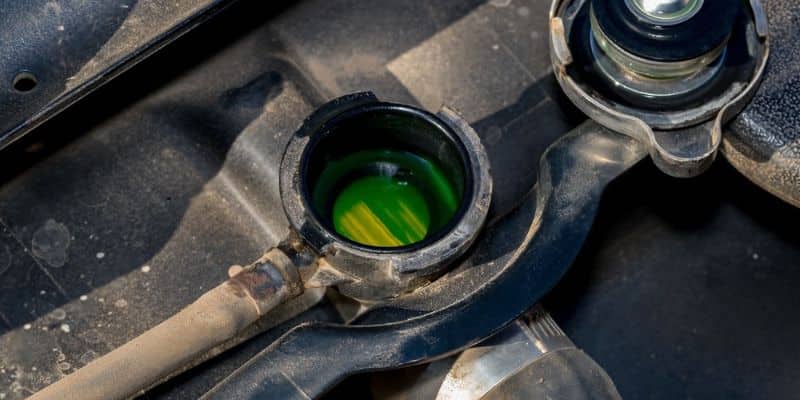The radiator and cooling system plays an important role in keeping your engine at a proper operating temperature. As the coolant circulates through it and carries heat away from vital components, it allows them to function correctly without overheating.
Let’s take a deeper look at why the coolant level rise when the radiator cap is removed from the radiator.
What is Happening Inside the Cooling System?
The cooling system in a vehicle operates under pressure when the engine is hot.
As the coolant gets warm, it expands and creates pressure inside the hoses, radiator, and engine blocks. This is because gasses like air can dissolve into the coolant fluid more readily at higher radiator hose temperatures.
The radiator cap acts as a pressure release valve. It keeps the system sealed shut until the internal pressure reaches a maximum safe level, usually around 15 PSI.
At this point, any excess pressure can vent out through overlapping flaps in the cap. This controls the internal environment.
Why does the Coolant Level Rise when the Radiator Cap is Removed?
When the cap is removed from a hot radiator, the first burst of rising steam and coolant occurs due to the sudden pressure release.
All the trapped gasses dissolved in the hot fluid quickly come bubbling out. But there is more to the fluid level increase than just this initial rush.
As the pressurized gasses escape and the internal pressure gets relieved, the coolant is then able to expand back to its maximum volume. Hot coolant takes up more space than cold. So with the pressure gone, it gains volume and rises higher in the cooling system until the cap is replaced.
8 Reasons for Coolant rise when the cap is removed
Here are the main reasons why removing the radiator cap would cause the coolant level to rise:
- Pressure release – The cooling system operates under pressure when hot to raise the coolant’s boiling point. Removing the cap suddenly releases this built-up pressure.
- Coolant expansion – As pressure is released, the coolant can expand back to its maximum volume. Hot coolant takes up more space than cold.
- Dissolved gases – Gases like the air that are dissolved into the coolant under pressure come out of the solution quickly. This causes bubbling and foaming that displaces coolant.
- Steam generation – Rapidly releasing pressure also allows trapped steam in the coolant to instantly vaporize, taking up more room than the liquid form.
- Air pockets – Trapped air in the system that was compressed under pressure expands outwards on release, displacing coolant.
- Head gasket leaks – A failed gasket allows combustion gases to enter the coolant, raising internal pressures beyond normal.
- Overheating damage – Excessive heat can warp head/cylinder materials, enlarging coolant jackets and creating more room for expansion.
- Low coolant level – With less volume to start, any expansion from pressure release is more likely to cause an overflow.
How Much Can the Level Normally Rise?
Most owner’s manuals will specify that it is common to see the coolant rise by around 1-2 inches within the radiator neck and overflow reservoir when the pressure cap is taken off a fully warmed-up engine.
Anything beyond 3 inches of increase could indicate issues like excessive air in the system.
What Should You Do After Refilling?
Once you have topped up the coolant after observing it rise and bubbles stop escaping, be sure to install the radiator pressure cap properly again.
The cap prevents coolant loss through evaporation or leaks while also maintaining system pressures which are crucial for effective heat transfer. Start and check for leaks before driving off.
Safety Precautions for Working with Hot Coolant
Anytime the cooling system is opened while warm, it is important to take safety precautions. Hot coolant and steam can cause severe burns. Here are some things to keep in mind:
Wait until cold
Never open a hot pressurized radiator. Allow the engine to fully cool before removing the cap.
Wear protective gloves
Thick leather gloves help provide an insulating barrier from scalding liquid.
Open slowly
If you cannot wait until cold, open the radiator cap slowly and cautiously to allow pressure to escape gradually.
Face away
Always face away and bend at the hips when opening the radiator, in case of a coolant splash or burst of steam.
Have a lid ready
Keep the radiator cap within reach so you can immediately seal it if there is a large surge upon opening.
Avoid inhaling steam
Steam vapor is hot and can scald lungs or cause breathing issues if inhaled in large amounts. Work in a well-ventilated area.
Taking simple precautions minimizes burn risks. The cooling system operates under extreme heat and pressures, so treated with caution when any part requires servicing or inspection while warm. Let everything cool completely first if possible.
Determining if Any Other Issues Exist
In most cases, a moderate coolant level rise of an inch or two when the pressure cap is removed is perfectly normal. However, larger increases or surfacing bubbles may be signs other problems need addressing:
Excessive foaming/bubbling could indicate a failing Water Pump causing air infiltration.
A rapid boilover or overflow may point to a Head Gasket leak between the coolant and combustion chambers.
Slow leaks that don’t seal up require inspection for external cracks, and pinholes in hoses or intake manifolds.
Over-pressurization risks damage, so verify the Radiator Cap still seals and vents precisely at the right pressure specification.
Air pockets or unusually high-level rises may mean Air is trapped and needs bleeding out through the bleed holes.
Investigate any unusual cycling symptoms or abnormalities further. Catching emerging problems early forestalls costly repairs down the road.
Why is my coolant overflowing when I take off the radiator cap?
Here are a few potential reasons why your coolant may be overflowing when you remove the radiator cap:
Overheating issues – If the engine has been severely overheating, it can sometimes cause the head gasket to fail. This allows coolant to mix with combustion gasses, producing excess pressure in the system. Removing the cap would allow this excess pressure to escape all at once.
Bad radiator cap – If the radiator cap is worn out or damaged, it may no longer be sealed properly. This means excess pressure could be building up in the system. A new cap is needed.
Air in the system – Air trapped in the cooling system can cause pressure to rise higher than normal. This additional pressure is released all at once when the cap comes off. The system may need to be bled of air.
Low coolant level – If the coolant is too low to begin with, there is less volume to absorb the expanding hot coolant. It may overflow the surge tank or radiator when the cap is removed.
Head gasket leak – Like an overheating issue, a failing head gasket can introduce combustion gasses into the coolant, over-pressurizing the system.
What happens if the coolant cap is not closed?
Here are a few things that can happen if the radiator coolant cap is left open or not closed properly:
Coolant loss – With the cap open, coolant can evaporate out of the system through the opening. This leads to a drop in fluid levels over time.
Overheating risk – The cap helps the system build pressure when hot. Without it sealed, pressure cannot be maintained and efficient heat transfer is compromised. This increases the overheating danger.
Coolant contamination – Dirt, debris, and moisture can get inside the cooling system if the cap is left off. This contamination reduces the coolant’s effectiveness.
Low boiling point – The pressure maintained by the cap raises the coolant’s boiling point. Without it, heat causes the fluid to boil over more easily during operation.
Difficult bleeding – Air entering through an open cap makes it harder to bleed air bubbles when refilling the system. Trapped air prevents circulation.
Potential leaks – An open cap allows the system to dry out hoses and seals over time from heat cycling. This can result in new leaks developing.
Preventing refill – Leaving the cap off while the engine is still warm makes refilling difficult due to coolant boiling over.
Proper sealing is important for the cooling system to function safely and efficiently. The cap should always be securely in place once refilling is complete.
FAQs
Is it okay to drive with a slightly low coolant level?
Driving with the reservoir under the minimum/cold fill line risks overheating damage. Top it up fully ASAP to maintain an adequate fluid volume buffer for thermal expansion.
What coolant type and mixture is recommended?
Use a 50/50 mix of high-quality antifreeze and distilled water suitable for your vehicle’s system metal and rubber components. Check the owner’s manual for specifics.
How long should coolant last before replacement?
Most manufacturers recommend coolant changes every 5 years or 100k miles for prevention. Check fluid condition regularly and replace sooner if signs of contamination or pH imbalance appear.
Conclusion
Understanding why the coolant rises with pressure release is important for properly maintaining your vehicle’s cooling system.
Taking precautions when working with hot fluids prevents injury while periodic checks help uncover small issues before expensive damage occurs.
Replacing worn parts and fluid according to the manual lifespan is also recommended routine practice to maximize component life.
With simple care and attention, the cooling system will continuously keep temperatures in a safe range for dependable engine operation.

Joseph Morgan has decades of automotive experience. The Detroit native started restoring classics in the 1970s. He owned a vintage repair shop and authored articles for car magazines. With a 1965 Mustang fastback of his own, Joseph now shares advice through his YouTube channel. From engine swaps to rust repair, his expertise helps preserve automotive history.
